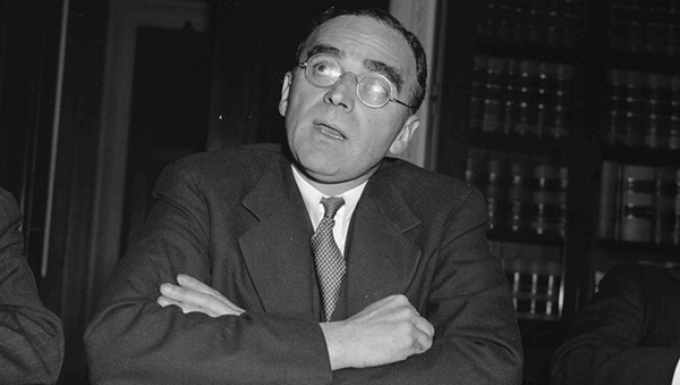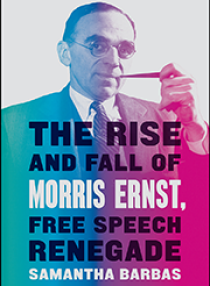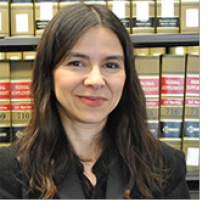
Morris Ernst, courtesy of the U.S. Library of Congress, Prints & Photographs Division, photograph by Harris & Ewing
Barbas recounts the life of a free-speech renegade
The source material was voluminous – 590 archived boxes of letters and personal papers, 21 published books and hundreds of other writings. So when Professor Samantha Barbas set out to write a biography of pioneering civil liberties attorney Morris Ernst, she soon discovered why other would-be biographers had failed. There was just so much.
But his was a story that deserves telling. Ernst spent decades as the American Civil Liberties Union’s general counsel, successfully arguing free-speech cases including his 1933 defense of James Joyce’s masterpiece Ulysses against obscenity charges. In his ACLU work, he pushed the organization to expand its portfolio beyond political speech and into artistic expression. “In the decade before World War II,” Barbas writes, “no one did more than Ernst to extend legal protections to literature, art, theater, and movies.”

Purchase this publication from
The University of Chicago Press.

Professor Samantha Barbas
Barbas eventually conquered the mountain of source material, mostly housed at the University of Texas at Austin. Her biography, The Rise and Fall of Morris Ernst: Free Speech Renegade, has just been published by the University of Chicago Press.
The author made six extended trips to Austin, read pretty much every page in the Ernst archives and estimates she captured 20,000 pictures with her phone by way of note-taking. Then there were the historical accounts of the era in which Ernst was active—largely from the 1930s to the 1960s—and personal interviews, including with Ernst’s granddaughter.
What she found and chronicled was a passionate and sharp practitioner who used his style and social savvy to push the envelope on free-speech rights in the United States. “He was a terrific trial lawyer,” Barbas says. “In the courtroom he had a personal flair about him—he was very flamboyant and brazen, a showman. He would make really startling arguments in court.
“He was definitely a free thinker in his time. The period he worked in was not one where most people thought about freedom of expression as being an important value, so to come out and say that the expression of all views is a social virtue and that it’s more dangerous to suppress speech than to let noxious facts out, that was really forward-thinking.”
As well, Barbas says, the conservatism of 19th century laws like The Comstock Act of 1873—infamous for its prohibition of possession and mailing of “obscene, lewd or lascivious” material—hadn’t caught up with the changing social mores of Ernst’s time. “We were not in the Victorian age anymore,” she says. “Women were wearing short skirts, and this was a relic that needed to be struck down.”
For all his liberal bona fides, Ernst had another side. Barbas details her subject’s late-career obsession with resisting Communist influence in the ACLU and the wider society, to the point that he endorsed FBI Director J. Edgar Hoover’s campaign to root out Reds and became an enthusiastic supporter of the House Un-American Activities Committee’s anti-Communist hearings.
“It’s almost like the very qualities that propelled him ahead also undermined him,” Barbas says. “One was an enormous ego. When Communist-affiliated people started joining the ACLU and other groups he was involved with, he felt his leadership challenged. His crusade against Communism was personal.”
Reviewers have praised the book for its scope and clarity, as well as the elegance of its writing. For Barbas, that’s a nod to what she says is the hard part of this kind of project. She says of the writing process, “I strive for a very clean style with an economy of words, and it just takes hundreds of drafts of cutting to get down to that point. The writing always takes a lot more time than the research.”
This is Barbas’ second biography; her book on Hollywood gossip columnist Louella Parsons was published in 2005. She is completing work on a book about the sociolegal history of New York Times Co. v. Sullivan, the U.S. Supreme Court’s landmark 1964 ruling that First Amendment protections of free speech limit public officials’ ability to win a defamation lawsuit.